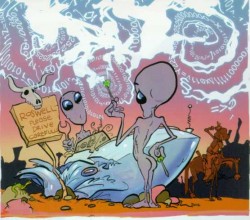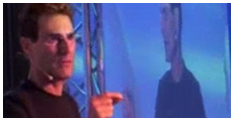Weird science
February 1999
Microchips copied from a crashed UFOs, computers that can be controlled by thought alone and real life time  machines: Uri Geller checks out some of the oddest gadgets in the galaxy.
machines: Uri Geller checks out some of the oddest gadgets in the galaxy.
Believe it or not, every word of what you are about to read is for real.
Let’s start with something that seems fairly down to earth: a microchip. Ah, but the new transfer capacitor made by the American Computer Company in New Jersey is no ordinary microchip: it’s capable of storing 300Gb of information – enough for 15 Hollywood blockbusters. ACC chief Jack Shulman claims his chip runs at 12,OOOGHz: around 20,000 times faster than the fastest Intel Pentium II chip you can buy. About the size of a casino baccarat chip, the TCAP takes millionths of a billionth of a second to implement a calculation.
Shulman comments that, “The implications are staggering. If I were Bill Gates, I’d be jumping for joy. There is no longer an upper limit to the performance possible for the common, everyday personal computer.”
Which is all well and good, but while it’s very impressive, there’s nothing odd about it. Or there wasn’t, until ACC cancelled its patent application on July 4th last year. Shulman issued press releases insisting he could not legally keep TCAP technology to himself, because that would violate the Outer Space Treaty, breaching international law.
His logic is that the TCAP, apparently, was backwards-engineered from a crashed alien spaceship recovered at Roswell, New Mexico, in 1947. According to UFOlogists, the US Government has been working on secret projects at the Nellis Air Force Range at Groom Lake, 90 miles north-west of Las Vegas, Nevada – the ‘above-top-secret’ facility codenamed ‘Area 51’ or ‘Dreamland’. Here scientists are said to unravel extra terrestrial technology in search of elements they can understand. The Roswell ship was fifty times more advanced than anything on post-war earth, believes Shulman – and the development of transistors in 1949 was the first direct result. In 1998, the TCAP was another.
“We realise that the TCAP was designed by a superior intelligence so as to overcome the problems either with super-cooling or over-complicated device designs,” says Shulman. “It’s quite fascinating.”
HOLD THAT THOUGHT
Sticking with the Roswell craft for a moment, nuclear physicist Jack Sarfatti has suggested it may have been piloted by thought control – its occupants setting the co-ordinates by visualising their destination. This technology now appears to be within human reach, after astonishing research carried out not on alien spaceships but on human paralysis victims. Roy Bakay heads a neurology team at Emory University in Atlanta, Georgia, which has developed an implant that sends thought signals from the brain to a computer.
Bakay buried glass cones the size of a ball point tip in the motor cortexes of two paraplegic patients, using a magnetic resonance imaging scanner to home in on the most active regions. The glass had been impregnated with neurotrophic chemicals taken from the patients’ own knees, to stimulate nerve growth. Neurons colonised the cones, attaching themselves like limpets to minute electrodes, and their signals were transmitted to a receiver-transmitter worn in a metal skull-cap.
By imagining body movements, the paralysed users were able to control the transmissions and move an on-screen cursor across a simple menu. ‘Lift left leg’ might translate to an upward scroll – ‘stamp right foot’ could click on a choice. The menu offers limited options, and one of the volunteers has since died of her sclerosis, but prototype Emory implants now enable one 57-year-old stroke victim to switch lights on or request food and water.
cursor across a simple menu. ‘Lift left leg’ might translate to an upward scroll – ‘stamp right foot’ could click on a choice. The menu offers limited options, and one of the volunteers has since died of her sclerosis, but prototype Emory implants now enable one 57-year-old stroke victim to switch lights on or request food and water.
Bakay’s team, which started by experimenting on monkeys, has taken eight years to reach this point, and faces several more years of testing before more detailed commands can be processed. The aim is to control artificial limbs, giving paraplegics new hope of walking, he told the Congress of Neurological Surgeons in Seattle. Linking to the Internet is another short-term aim: “if you can run a computer, you can talk to the world,” says Bakay.
The possible non-medical uses are truly mind-boggling. Operating computers, TVs and household appliances by thought-power is just the beginning: Emory implant wearers will be able to communicate by electronic telepathy, firing impulses between their transmitter caps. And if TCAP processing power takes hold, virtual reality will be significantly more convincing, and with thought control, humans will be able to mould their surroundings in the flash of a synapse. You want to be on a sunny beach? just think about it for a second…
QUANTUM LEAPS
Dr Fred Alan Wolf, award-winning theoretical physicist, believes the human mind can do more than just create a universe – it can leap around the future, too. In a paper presented at the Vigier conference, called The Timing of the Conscious Experience, Wolf declared: “We are all psychic, whether we like it or not. Our brains operate more like time machines, and information from the future must influence choices that we have made in the past. This is an evolutionary transformation, and species which didn’t pick up this very important capability died out.”
Wolf is talking about quantum physics, the revolutionary spin-off from sub-atomics where particles can exist simultaneously in two places. Just observing quantum particles affects the way they behave. In his book Hyperspace, New York professor of physics Michio Kaku combines Wolfs quantum theories with Einstein’s relativity equations to design a time machine: ‘It consists of two chambers, each containing two parallel metal plates. Intense electric fields created between each pair of plates rip the fabric of space-time, creating a hole in space that links the two chambers.” Kaku admits the technology to create such powerful electro-magnetic circuitry doesn’t yet exist – but then he was writing before the advent of TCAPs. If one of the chambers is moving at an immense speed – in space, for example – Einstein’s laws dictate there will be a time-lag, with the clock ticking more slowly in space than on Earth. Anything stepping through the door here will emerge at the other end in the past.
And if the spaceship is piloted by Emory implants, it will be back home in the twinkling of a thought. The practical applications are currently slim, but the theoretical implications are massive. The time-traveller could reach Earth in time to meet himself and order himself not to step through the doorway. So now what?
Kaku’s answer is simple – and convincing enough to make time travel an even more mind-shaking possibility. When the traveller steps back in time, he also steps into another universe. All those two-timing quantum particles making up all the incalculable trillions of atoms in the universe cannot behave the same way twice. Something different happens to the universe every time the traveller heads backwards, effectively creating another universe running parallel to this one. So he might arrive in a world where unicorns roam on Hampstead Heath, and Chateau Petrus is only four pence a bottle. Or he might vanish in a scenario where life never evolved at all.
TUMMY TROUBLE
If you’re sceptical about Back To The Future, how about Fantastic Voyage? Can you imagine travelling through your own body? Israeli scientist Gavriel Iddan, of the Rafael Arms Development Authority, has devised a disposable capsule the size of a vitamin pill containing a camera no bigger than a microchip, a miniscule light source, transmitters and a power cell. During its seven-hour passage through the digestive tract, the camera broadcasts to a receiver on a belt. Currently, the belt is removed after the capsule is ‘expelled’, and the receiver then downloads to a workstation where real-time video of the intestine can be viewed. But soon, live transmissions will be available.
On the split-screen display, images of the gut appear beside a map pinpointing the capsule’s location. Current endoscopic imaging techniques, where the camera is inserted down the throat on a tube, can’t be nearly so accurate – all the surgeon can know is how much tubing has been paid out.
The implications for medicine are massive. Gavriel Meron, Chief Executive of the Rafael subsidiary which is testing the capsule, points out that endoscopy and other methods such as X-rays miss around 20 per cent of gastrointestinal ailments, including malignant cancers. “With that kind of failure rate,” he says, “you can’t talk about early detection”. Iddan’s capsule isn’t expected to reach the market until after the year 2000, but Meron is confident it is only the first in a family of internal cameras.
The future may be bright, but the past is somewhat more murky: Rafael, where Iddan is head of electro-optics research, is after all a military establishment. Rumours are circulating that the initial technology was part of a missile head, but Meron denies it: “It’s not part, as far as I know, of any defence system”. But then he would say that, wouldn’t he?
DOUBLE TROUBLE
While your mind’s still happily boggling away, let’s go back to quantum mechanics. That idea of particles being affected by observation is known as Heizenberg’s Uncertainty Principle. Formulated in 1927, it cuts both ways – if a particle is not observed, it exists in every possible state. It does not settle down and make its choice until it is measured. So a particle of matter could also be a wave of energy, and a radioactive atom may be decayed or it may be whole. Until we look, nothing is certain.
Existing in one known, static condition requires no energy. But existing in two oscillating conditions simultaneously isn’t so economical. Energy is required. Even a vacuum frozen to absolute zero will require energy. And a vacuum at absolute zero is a succinct description of most regions in outer space.
Physicists have argued for decades whether spaceships could convert this energy. The debate got hot in 1948, when the Dutch scientist HBG Casimir used a pair of gold-coated quartz plates and a torsion pendulum to demonstrate zero-point energy did exist. The motion of the pendulum, twisting one of the plates, could not be explained unless the zero-point was built into calculations.
Russian researchers, in an attempt to make up for their lack of alien craft, tried bombarding water with sound to create air pockets which imploded, creating energy flashes. Nobel Prize-winner Julian Schwinger pointed to zero-point energy as the cause, but the trail went cold with the advent of perestroika.
Hal Puthoff, Director of the Institute for Advanced Studies in Austin, Texas, has reopened the controversy with an outrageous claim: that zero-point energy is the force that holds electrons in orbit round an atom’s nucleus. “It implies that hydrogen injected into cavities might produce excess energy,” he said. With the energy taken out, atoms would shrink. Imagine a device that reduces a potato to powder – but instead of merely dehydrating it, you are extracting enough power to run your central heating for a week.
LETHAL KEY-RINGS
But enough of the theories and the physics, you can already get hold of a product that is just as mind-boggling in its nature and its functions: a mere key-ring. The Bulgarian Osa, or Wasp not only keeps your doorkey safe, but also detects radiation, fires .32 calibre bullets and evades airport security systems. The £12.50 device was designed by Viktor Staef, who proudly declares: “This is the latest descendant of the Bulgarian poison-tipped umbrella”.
First conceived as a pistol to fire tear-gas capsules, the gadget is aimed at the Indian and Pakistani market, mainly as a women’s self-defence weapon. “Women shy away from guns,” said Staef, “so it gave me the idea to make it look like something they would find sympathetic. It comes in 99 different shades, so you can match it with the colour of your eyes, clothes, lipstick or your car.” With nuclear tests underway in the sub-continent, the Geiger counter is an added attraction.
But Staef isn’t stopping there. At his workshop in Pazardzik, south-east of Sofia, he has also created an air rifle which converts to an underwater harpoon and a drinks cooler. Sounds ideal for serving martinis – shaken, not stirred.
Uri Geller’s novel Ella is published by Headline Feature at £5.99, his Little Book Of Mindpower by Robson Books at £2.50 and Jonathan Margolis’s Uri Geller, Magician or Mystic? by Orion Books at £17.99. Visit his website at https://www.urigeller.com and e-mail him at [email protected]


Latest Articles

Motivational Inspirational Speaker
Motivational, inspirational, empowering compelling 'infotainment' which leaves the audience amazed, mesmerized, motivated, enthusiastic, revitalised and with a much improved positive mental attitude, state of mind & self-belief.


















